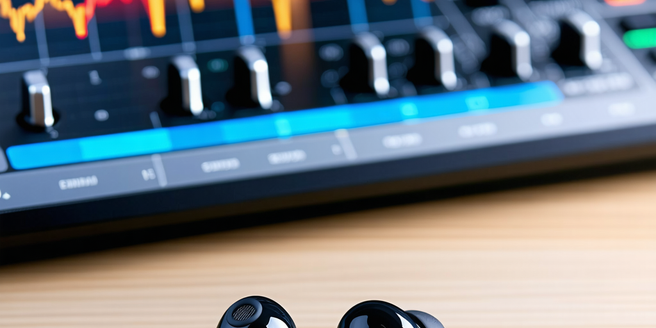Sound Quality In Affordable Wireless Earbuds

Understanding Sound Quality Basics
Sound quality in earbuds involves the clarity and depth of audio reproduction. It includes frequency response, sensitivity, and impedance, which affect how sound is perceived from a device. Frequency response refers to the range of sound a device can produce, typically from bass to treble, measured in Hertz (Hz). Sensitivity determines how loud earbuds can get from a given power source, measured in decibels (dB). Impedance, measured in ohms, affects how much power earbuds need to produce sound. Lower impedance requires less power. Sound quality basics help users understand what parameters influence the listening experience. Finding the right balance between these attributes helps ensure earbuds deliver clear and vibrant audio without distortion, making them crucial for buyers prioritizing sound quality when considering affordable wireless earbuds.
Importance of Drivers in Earbuds
Drivers are crucial components in earbuds, converting electrical signals into sound. They primarily determine the quality of audio output, affecting bass, mids, and treble. The size and type of the driver usually indicate its potential performance, with larger drivers often producing better bass. Common driver types include dynamic, balanced armature, and planar magnetic. Dynamic drivers are popular in affordable wireless earbuds due to their ability to produce robust sound and deep bass at a lower cost. Balanced armature drivers offer more detailed sound but are often more expensive. Planar magnetic drivers are rare in affordable models but provide high-quality sound reproduction. Understanding drivers helps consumers make informed choices, ensuring their earbuds deliver satisfying audio experiences without breaking the bank. Therefore, evaluating the drivers’ specifications is essential for anyone seeking superior sound quality in wireless earbuds.
How Bluetooth Technology Impacts Sound
Bluetooth technology is a wireless standard crucial to the convenience of earbuds, impacting both sound quality and connectivity. The evolution of Bluetooth versions, particularly Bluetooth 5.0 and above, has enhanced audio transmission by increasing bandwidth and improving energy efficiency. This results in more stable and clearer sound, with reduced latency and interference. However, the compression involved in Bluetooth audio can still affect quality compared to wired connections. Advanced codecs like aptX, AAC, and LDAC play significant roles in maximizing sound quality, offering better compression, and providing near-lossless audio experiences. Understanding these Bluetooth aspects helps consumers expect realistic audio performance from their wireless earbuds. When choosing affordable models, it is essential to consider whether they support advanced Bluetooth codecs to ensure the best possible sound experience without compromising on convenience.
Evaluating Bass, Mids, and Trebles
Evaluating bass, mids, and trebles is essential in assessing sound quality in earbuds. Bass refers to the low frequencies, adding depth and impact, while mids handle vocals and instruments. Trebles focus on higher frequencies, providing clarity and detail. Ideally, earbuds should have a balanced sound signature that retains bass depth without overpowering mids and trebles. In affordable earbuds, manufacturers often focus on enhancing bass, as it is generally the most noticeable aspect of sound, sometimes at the cost of clarity. Users should listen for a well-rounded bass that doesn’t distort other frequencies, ensuring vocals and instruments remain clear and precise. Trebles should be crisp but not overly sharp or shrill. By understanding how these sound elements interact, buyers can more effectively judge the music profile produced by different earbuds, ensuring a satisfying listening experience.
Noise Isolation and Its Role
Noise isolation refers to passive blocking of external noise by physical means, crucial in enhancing sound quality in wireless earbuds. It involves the design and material of earbud tips and housings that seal the ear canal, preventing ambient noise from intruding into the audio experience. Good noise isolation allows listeners to enjoy music at lower volumes, reducing ear strain and better preserving audio details. Unlike active noise cancelling, which uses electronics to counteract noise, noise isolation doesn’t require power, making it suitable for affordable models. Effective isolation accentuates clarity and immersion, allowing users to focus on music without distractions. To achieve optimal noise isolation, proper fit and selection of ear tips are essential, as they significantly influence the overall perception of sound quality in day-to-day use of affordable wireless earbuds.
Comparing Affordable Brands
When exploring affordable wireless earbuds, it’s important to compare brands to find the best sound quality for the price. Brands like Anker Soundcore, JBL, and TaoTronics often provide excellent value, combining sound quality with competitive prices. Anker Soundcore focuses on balanced sound profiles with decent bass and clear mids. JBL’s affordable models, known for robust bass, also handle mids and trebles well. TaoTronics offers budget-friendly options with satisfactory audio performance and reliable Bluetooth connectivity. When comparing brands, consumers should look at user reviews, expert opinions, and specifications, including frequency response, driver type, and Bluetooth codec support. The right choice often balances audio performance with essential features like battery life, design, and comfort. By evaluating what different brands bring to the table, buyers can choose earbuds that not only fit their budget but also deliver a superior listening experience.